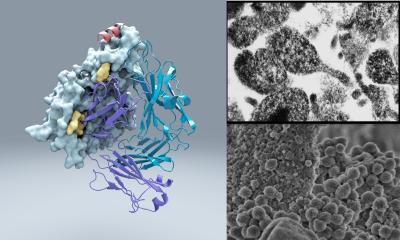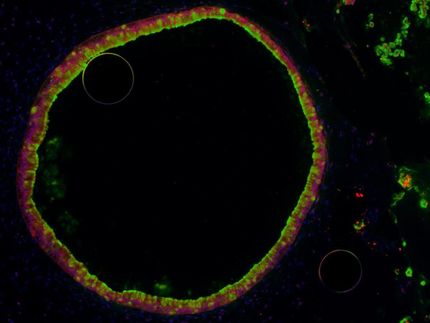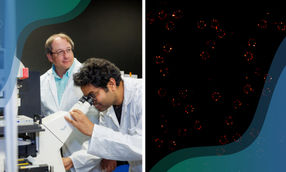Stem cells help researchers peg rabies resistance
Researchers at Texas A&M AgriLife Research have developed a new technology to determine sensitivity or resistance to rabies virus.
"We were able to create a novel platform such that we could look at how pathogens, such as bacteria or virus or even drugs or radiation, interact with specific human genes," said lead researcher Dr. Deeann Wallis, AgriLife Research assistant professor of biochemistry and biophysics. "It allows us a new way to profile the genes involved in sensitivity or resistance to certain agents."
The rabies work is being reported in the journal Stem Cells.
"Our study is the first to show pre-existing libraries of mutant stem cells can be differentiated into different cell types en mass and screened to identify meaningful genes involved in a cell's response to infection," Wallis said. "Moreover, this technique can be used to identify human genes that are involved in any type bacterial or viral infection, or even response to drugs, toxins or radiation. This is a relatively novel way for researchers to discover gene function and assess human host response."
Understanding sensitivity or resistance to rabies is important, she said, not only because the disease still causes 55,000 deaths a year globally, but it could also potentially be weaponized and used as a biowarfare agent.
Wallis said the five-year study used murine embryonic stem cells from a library of mutant stem cells typically used to generate knockout mice.
A knockout mouse is a laboratory mouse in which researchers have inactivated, or "knocked out," an existing gene by replacing it or disrupting it with an artificial piece of DNA, according to the National Human Genome Research Institute. Such cells and mice are frequently used as a model to study human genes, Wallis noted.
She explained that each stem cell clone has a different gene mutated.The researchers took a panel of a variety of different genes and were able to query each cell line separately.
"For the first time ever, we were able to take thousands of different stem cell lines, each carrying a separate mutation, and differentiate them into neurons," she said. "It was quite a large task to miniaturize this. We were able to show with genes that are known to be involved in rabies virus that if we mutated a gene in the mouse, we still can see differences in sensitivity and resistance to rabies virus in these cells.
Knockout mouse stem cells have only one copy of each gene, whereas a regular cell would have two copies of every gene. Therefore, other researchers thought it was not possible to see an impact of a particular gene because half of it is still there, she said.
The research team grew embryonic stem cells in an array of approximately 100 per plate, differentiating them into fully functional neurons. Then, fluorescent green rabies virus was added and plates were photographed daily for several days. An image analysis program was used to measure how much green was on each picture.
"The results are basically sorted on the high amount of green, meaning these are really sensitive to rabies, and the resistant ones that have very little green," Wallis said. "We were able to identify 63 different host target genes. These genes represent new pathways that can be targeted for treatment of rabies.
"If we are able to target host-based genes with drugs, they would mutate much less rapidly than viral or bacterial genes, and so we would have fewer problems with resistance."
She said researchers are already considering the technique for further studies on tuberculosis, botulism, ebola and even attention deficit hyperactivity disorder.
"There's no end to the possibilities for screening stem cells in this way," Wallis said.
Most read news
Other news from the department science

Get the life science industry in your inbox
By submitting this form you agree that LUMITOS AG will send you the newsletter(s) selected above by email. Your data will not be passed on to third parties. Your data will be stored and processed in accordance with our data protection regulations. LUMITOS may contact you by email for the purpose of advertising or market and opinion surveys. You can revoke your consent at any time without giving reasons to LUMITOS AG, Ernst-Augustin-Str. 2, 12489 Berlin, Germany or by e-mail at revoke@lumitos.com with effect for the future. In addition, each email contains a link to unsubscribe from the corresponding newsletter.
Most read news
More news from our other portals
Last viewed contents
Charley_horse
DxS Appoints David Jackson as Vice President of Business Development and Licensing
Melinda_Gates
SYGNIS strengthens IP position in the treatment of acute stroke with AX200 in the US
Merck Decides Not to Pursue Evofosfamide Further in Soft Tissue Sarcoma and Pancreatic Cancer
Researchers optimizing progesterone for brain injury treatment - New approaches include adding vitamin D and using water-soluble analogues

The ultimate decoy - Scientists find protein that helps bacteria misdirect immune system
Researchers rapidly turn bacteria into biotech factories
PBL InterferonSource founder, Sidney Pestka, MD, to receive 'Distinguished Service Award' from 'ISICR'
Fabry's_disease























































